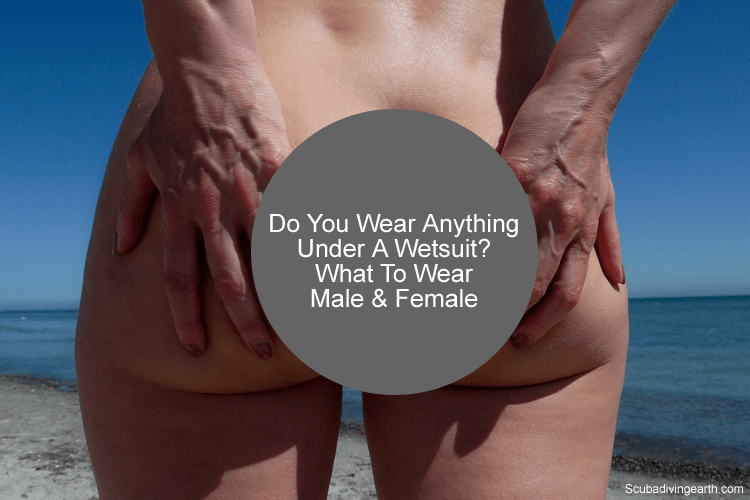
What do you wear under a wetsuit for scuba diving?
If you are new to scuba diving or snorkeling and you’re not too sure on what to wear under your wetsuit, this article will answer your questions.
To answer the question ‘do you wear anything under a wetsuit‘ depends on your personal preference. You can choose to go commando and wear absolutely nothing under your wetsuit. Most people don’t wear much under their wetsuits other than a bathing costume. Male divers mostly wear board-shorts or speedos and female divers wear a bikini or one-piece swimsuits.
What is best to wear under a wetsuit?
The best option for men and women is to wear cycling shorts or similar under a wetsuit or women can wear a one-piece swimsuit. The thinner the material, the better and more comfortable it will be. You want the undergarment to be made of material that dries quickly for when you remove your wetsuit. Continue reading to find out more about other important considerations when choosing what to wear ender a wetsuit.
If the water is colder, change to a thicker wetsuit or use thermal Lycra or neoprene shorts under your wetsuit. That way you’ll get extra insulation and stay warmer.
The best way to do more diving is to book yourself on a scuba diving liveaboard. You can check the latest and best deals on liveaboards using the following window:
Before explaining in more detail about what to wear under your wetsuit, I want to explain how wetsuits work. This will help you better understand why you don’t necessarily need to wear anything under your wetsuit.
Please don’t leave before you watch the video in this article! After you’ve got your answer about wetsuits, you may like to watch the video on this article too. I almost don’t want to spoil the end of the video, so all I will say is it involves a carcass, many sharks and a single grouper…you may be surprised at what happens, I certainly was!

How does a wetsuit keep the wearer warm and how does a wetsuit work?
Wetsuits are made from a synthetic type of rubber called neoprene (see below). As the name “wetsuit” suggests, wetsuits don’t actually prevent you from getting wet. Which is different to a drysuit, which keeps you dry.
A wetsuit is designed to keep you warm using a thin layer of water. This thin layer of water enters the wetsuit and lies between the wetsuit and your skin.
Your wetsuit should be tight enough to fit snugly, a bit like a glove. But it shouldn’t be too tight so it cuts off your circulation.
The snug fit should be such that only a minimal layer of water enters the ‘space’ between your wetsuit and your skin. This layer or film of water needs to be thin so it’s easily warmed up by your body heat. Talking about entering water, but in the sense of a scuba diver entering the water, you may not be able to stop yourself laughing out loud when you watch the video at the end of this post about the 5 scuba diving entry techniques.

Do you get wet in a wetsuit?
You do get wet in a wetsuit and when you first enter the water there’s always an initial chill. This initial chill is caused by water entering the space between your skin and the wetsuit. But once this layer of water is warmed to body temperature, the insulating properties of your neoprene-made wetsuit will keep you warm.
If your wetsuit is too baggy and the gap between your wetsuit and your skin is to big you will experience ‘flushing‘. The problem of wetsuit-flushing will be made worse if the neck, wrist and ankle seals are loose.

What does ‘flushing’ mean in respect of wetsuits?
Flushing is when cold water enters and flushes through a loose-fitting wetsuit. The thin layer of water under your wetsuit, which is designed to keep you warm, is ‘flushed‘ out before it has a chance to warm up properly.
A ‘flushing‘ wetsuit will result in the water taking heat away from your body instead of it remaining there to keep you warm.
Talking about flushing a wetsuit, you may like to read about how to clean a smelly wetsuit, which includes the smell of urine. I include useful tip to use on a dive if you need to pee.
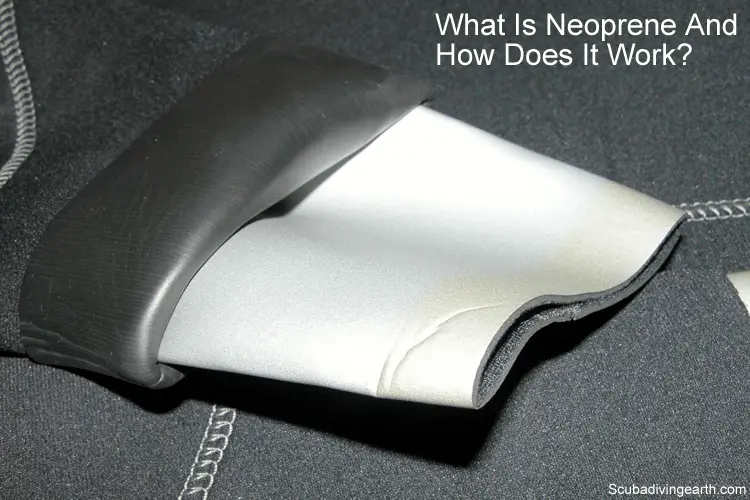
What is neoprene and how does it work?
Wetsuits are made from a material called foamed neoprene.
Foamed neoprene is made from a synthesised rubber. The ‘foaming’ process is what helps to thicken the neoprene. This is what gives neoprene the thermal insulating properties for use in water.
This foaming process also gives neoprene its buoyant properties too. Scuba divers need to add weight to compensate for this added buoyancy in order descend.
More Reading: How does a buoyancy control device work?
Neoprene itself has been around since the 1930’s. It has been used in a number of other applications too.
Heat transfer or heat conduct is the transfer of energy between objects that are in physical contact with each other. If this heat transfer can be slowed by using certain materials, this is what creates thermal insulation.
Foamed neoprene offers good thermal insulation because it contains small bubbles of nitrogen gas. Nitrogen is a poor conductor of heat, which is what makes it the perfect thermal insulator.
With foamed neoprene, this heat transfer occurs mainly through diffusion. But it’s the presence of nitrogen bubbles that slows down any diffusion. This in turn reduces heat loss from your body, and is what creates the thermal insulation needed in water.
Why scuba diver need to wear wetsuits in water
The thicker the foamed neoprene or the thicker your wetsuit, the better the thermal insulation in water.
One of the reasons why you feel hungry after scuba diving is because of the extra heat loss underwater.
You can burn up to 600 calories per hour scuba diving, and heat loss is a main contributor to this. In water we loose heat 25 times faster than on land, which is why you need to be thermally insulated with an exposure suit like a wetsuit.
More Reading: How does scuba diving burn calories?
A wetsuit is great in water temperatures down to around 14-15 °C (57-59 °F). Perhaps a bit lower if you’re brave or if you’re more resistance to cold water. Anything much below these temperatures you are better to us a semi-dry suit or a drysuit.
More Reading: Does a dry suit keep you dry (What are the exceptions & do you get wet)
In addition to considering water temperature, you also need to consider the activity you are doing, i.e. how much vigour or what’s the activity level.
Plus consider your own personal sensitivity to getting cold. Which of course is different for everyone and is different between men and women too.
With a better understanding of how a wetsuit works, lets now consider what to wear under a wetsuit.
More Reading: Why am I so hungry after scuba diving?
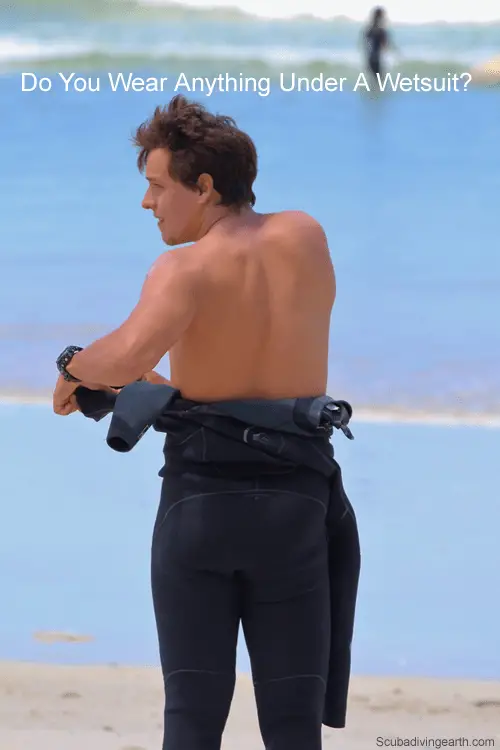
Do you wear anything under a wetsuit?
Turning to the original question of ‘do you wear anything under a wetsuit?’ Let’s take a look at the options for this.
Have you heard about the ‘Scuba Diving Lizard‘? Take a read of this article about a lizard that can breathe underwater from a scuba-tank like bubble…I was fascinated when I read this!
Do you need to wear anything under a wetsuit?
You don’t need to wear anything under a wetsuit and many wetsuit-wearers go commando and wear nothing. You must bear in mind that whatever you wear under your wetsuit will get wet, which means if you wear nothing, only you get wet. Read on to discover whether or not it’s a good idea to wear nothing under a wetsuit.
Going naked or commando – this option applies to male and female divers alike
The best option of ‘what to wear under your wetsuit‘ is to go totally naked or commando under your wetsuit. Yes you heard me right, you can be completely naked underneath your wetsuit.
As already explained, it’s the combination of the wetsuit material (i.e. the foamed neoprene) and the thin layer of water between your wetsuit and your skin that keeps you warm. It’s not what you wear underneath your wetsuit that will keep you warm.
In fact by having nothing between your wetsuit and your skin lessens the amount of water that can get in. This in turn will help your body to warm a thinner layer of water up. Which means you should be warmer when you’re naked under your wetsuit.
However, the option of going naked under your wetsuit is more challenging if you are planning to change in a public place.
This is especially true if you don’t have anywhere to cover up and be discreet. But even more challenging if you’re a female wetsuit user! Women wetsuit wearers have more bits to cover up than men and are more likely to get unwanted attention.
Wetsuits aren’t the easiest of things to put on and take off. Let alone trying to do this at the same time as trying to cover your naked body. The last thing you need is to get yourself arrested for indecent exposure!
If going commando under your wetsuit isn’t an option or isn’t your thing, then please read-on to discover the options for males and females and what each should wear under a wetsuit.
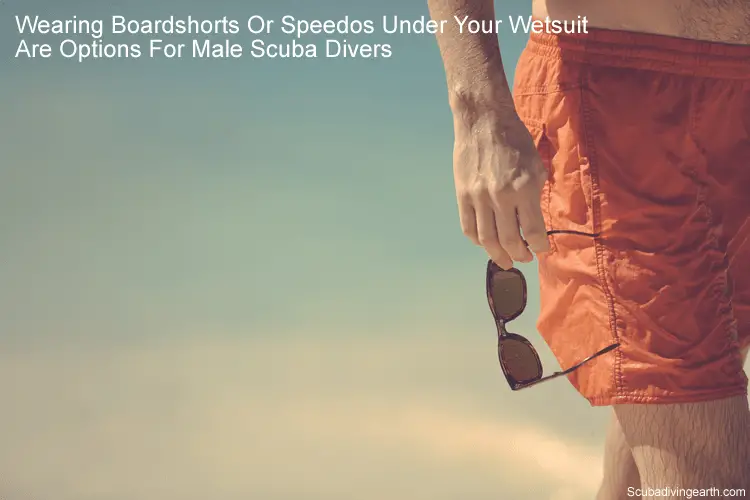
What to wear under wetsuit male – Wearing board shorts or speedos under your wetsuit are options for male scuba divers
For men it’s perfectly okay to wear board shorts under a wetsuit. But for comfort purposes choose a pair of less bulky board shorts. If your your board shorts are extremely baggy or have excess material and thick seams this may be uncomfortable to wear underneath your wetsuit.
Also, a good fitting wetsuit which is snug to the body works best at keeping you warm. Which means bulky board shorts may affect your warmth.
These days, board shorts are the most common form of beach attire for men. But an alternative to wearing board shorts as a male diver, you could consider wearing speedos (racers, ball-huggers, dick-stickers or nut-huggers, depending on where you live in the world!).
The benefit of wearing speedos (or whatever you call skimpy swimming trunks for men) is that they are minimalist and fit snugly. Which means they won’t affect how your wetsuit fits over them.
But if you wouldn’t be seen dead in a pair of tight fitting swimming trunks, as I know a lot of men wouldn’t (myself included), then the first option of going naked under your wetsuit is a good choice. Followed by board shorts.
What to wear under wetsuit male – other considerations
There are a number of other considerations for male wetsuit wearers to consider, which include:
- Big and bulky board shorts are more uncomfortable to wear under a wetsuit.
- If you are diving on a boat you may not want to go commando under your wetsuit. Unless you have a private place to change.
- When you rent or hire your wetsuit you may not wish to go commando.
- If you’re not practiced at getting in and out of your wetsuit with other people around, you probably better not go naked to avoid embarrassment.
- If you don’t like speedos or their equivalent, consider wearing spandex shorts or compression shorts for men.
- When the water temperature is colder than expected wear a thicker wetsuit or use a thermal Lycra or neoprene shorts under your wetsuit. This way you’ll get extra insulation and will stay warmer.
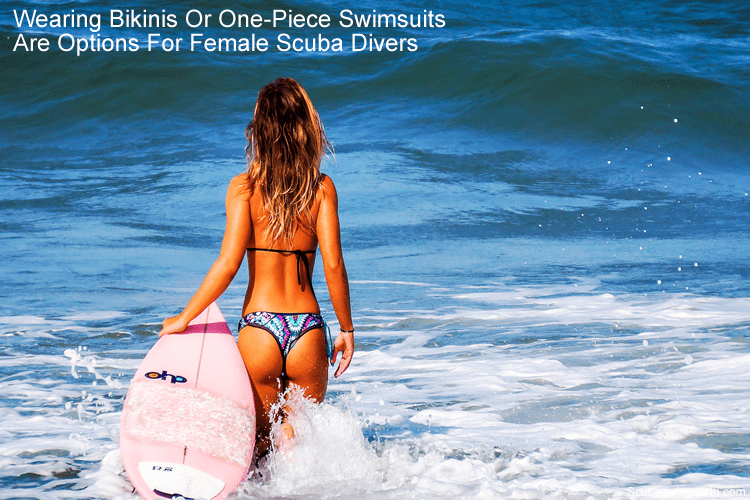
What to wear under wetsuit female – Wearing bikinis or one-piece swimsuits are options for female scuba divers
For female divers bikinis and one-piece swimsuits are ideal to wear underneath a wetsuit because they are minimalist. But if you don’t like the sight of ‘lines‘ from your bikini or swimsuit showing through you may consider going naked or commando under your wetsuit.
But don’t do as I nearly did when I was scuba diving in Bonaire and forget you’re naked underneath your wetsuit. I did just this and started taking my wetsuit off in public. Fortunately, I realised before I’d taken if off all the way!
Female swimsuits are ideal as these usually hug the body tightly and should not shift as you pull-on your wetsuit. Tight fitting women’s swimsuits shouldn’t affect the insulating properties of a wetsuit.
Depending on your preference as a woman whether you prefer to wear a bikini or a one-piece swimsuit doesn’t really matter, as both will work as well as the other so go with your preference.
What to wear under wetsuit female – other considerations
There are a number of other considerations for female wetsuit wearers to consider, which include:
- If you wear a bikini under your wetsuit be careful when taking your wetsuit off that your bikini top doesn’t come off with it. This is especially true with the flimsy type of bikinis.
- If you’re worried about your bikini top coming off when you remove your wetsuit consider wearing a swimsuit instead.
- If privacy is a problem don’t consider going naked under your wetsuit. Otherwise you’ll attract unwanted attention.
- Wear a sports bra under your wetsuit. You could combine this with bikini bottoms, spandex shorts or compression shorts.
- Consider using a sports bikini as these tend to fit tighter than a normal bikini, which are a bit like a sports bra and are better when removing your wetsuit.
- When renting or hiring a wetsuit you may not wish to go commando.
- If your bikini top is the tie-type-bikini be careful the tie-strings don’t get caught in the zip if it’s a back zip wetsuit.
- Wear a tankini along with bikini bottoms.
- If your swimsuit has knots or large buckles or embellishments avoid wearing this style of bikini as these will dig into your skin under your wetsuit. Always use flat clasps and streamlined swimsuits where possible.
- If you are diving on a boat you probably don’t want to be going commando under your wetsuit.
- When the water temperature is colder than expected wear a thicker wetsuit or use a thermal Lycra or neoprene shorts under your wetsuit. This way you’ll get extra insulation and will stay warmer.
More Reading: Can you scuba dive if you are pregnant?
Wear a rash guard or rash vest under your wetsuit which is an option for males and females
The other option for both male and female divers is to wear a rash guard or rash vest. This is instead of or in addition to board shorts for men and bikinis or one-piece swimsuits for girls.
The benefit of wearing a rash guard or vest is it will help to stop chafing, which is what can happen on certain parts of your skin. Especially in sensitive areas. This normally happens to me under my armpits. A rash vest helps prevent this problem from happening.
The alternative to using a rash vest if you’re wearing it to prevent chaffing, is to use anti-chafing gel or cream combined with your choice of wetsuit-undergarment.
What do you wear under a wetsuit in cold water?
For extra warmth in colder waters you could wear thermal Lycra underneath your wetsuit. This will add an extra layer to help prevent heat-loss. But if you have additional material under your wetsuit this means you have a greater later of water to warm up when you first enter the water.
Some newbies to scuba diving or snorkeling ask ‘do you put something under your wetsuit if you are cold?’ Depending on how cold the water is it might be better to wear a thicker wetsuit instead of wearing an extra undergarment underneath a thinner wetsuit. The colder the water, the thicker the wetsuit you should wear.
If the water is very cold, for example if it’s below 14-15°C (57-59°F), the question may not be about what you wear underneath your wetsuit, but whether you wear a wet suit at all.
In colder waters consider a semi-drysuit or a dry suit
Instead of a wetsuit you may need to consider switching to a semi-dry suit or a drysuit, as these are more suited to colder water temperatures.
This is especially true if you are in the water for prolonged periods. But also if you intend to do a second dive.
If you are diving when the air temperature is on the cooler side, and you are diving more than once from a dive boat, you are better to use a drysuit.
You might like to read this article about what is it like to dive in a drysuit.
Before I bought my dry suit I used to dive in a semi drysuit. I did loads of diving up in the North Sea around the Farne Islands. Not only is the water cold (8-9°C or 46-48°F), but we used to dive in late September/early October when it was cold weather too.
It wasn’t until I started using a drysuit that I realised the benefit of how this keeps you warm out of the water between dives. Whereas a semi drysuit and a wetsuit wouldn’t keep you warm.
However, if you intend to use a wetsuit think about how cold the water is. The thickness of your wetsuit you choose will depend on your own personal sensitivity to cold water.
Additionally, how cold you get will be affected by the activity you are doing.
Scuba diving is a very sedate sport as you are encouraged to take things slowly to conserve air. But if instead you are using your wetsuit for surfing or swimming in the sea, then these activities will help raise your body temperature and keep you warm.

Do wetsuits keep you warm out of the water?
Wetsuits are designed to keep you warm in the water using the combination of the foamed neoprene thermal properties and the thin layer of water. But out of water, and in particular if it’s cold and windy, a wetsuit will have the opposite effect out of water.
Once you have finished your water activity in your wetsuit you are far better to take your wetsuit off when out of the water. Always dry-off and put your clothes back on to keep warm out of the water.
Do shorty wetsuits keep you warm?
Shorty wetsuits will keep your torso and core body warm, but not your arms and legs. This is because your calves and your forearms will be open to the water and is why shorty wetsuits are better used in warmer waters.
If you are diving in colder water using a shorty wetsuit with your legs and arms exposed you are probably better to switch to a full-length wetsuit instead.
Be aware of getting cramp in colder water when wearing a shorty wetsuit. Your calves will be exposed in a shorty and these muscles are prone to cramping up in cold water. You may be better in a full length wetsuit if you are prone to lower leg cramps in cold water.
What to wear under a wetsuit for snorkeling?
What you wear under your wetsuit for snorkeling is no different to what you wear when you’re scuba diving or when you’re simply swimming in the sea.
So if you’re a male snorkeler you should wear board shorts or speedos. But if you’re a female snorkeler then a bikini or a one-piece bathing suit will be ideal.
However, if you like the idea of going commando under your wetsuit there’s nothing to prevent you from doing this when you snorkel too.
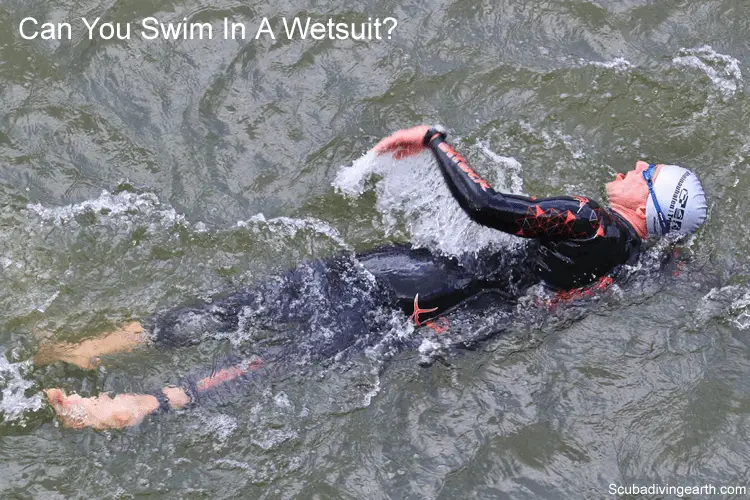
Can you swim in a wetsuit?
You can swim in a wetsuit, but depending on how thick the wetsuit is and what type of swim stroke you are using, this will make a difference to how well you’ll be able to swim.
If for example, if you intend to swim using front-crawl may be more of a challenge. Especially in a very thick wetsuit. The thicker the wetsuit the more restrictive it will be and the more difficult it will be to swim normally.
More Reading: Essential scuba diving equipment
I hope you enjoyed this article about do you wear anything under a wetsuit
I’d love to hear from you. Tell us about your adventures of diving and snorkeling, in the comments below. Please also share your photos. Either from your underwater cameras or videos from your waterproof Gopro’s!
If this article hasn’t answered all of your questions. If you have more questions either about snorkeling or types of scuba diving (or specifically about do you wear anything under a wetsuit), please comment below with your questions.
There will also be many more articles about scuba diving (and snorkeling) for you to read and learn about these fabulous sports.
Have fun and be safe!





I go naked under a wetsuit in a nudist area, anywhere else, would wear speedos, or speedos under normal clothes, I am male.
Hello Robin, thank you for your comment – I noticed it as I’m writing a new article. I hope you are enjoying reading my diver blog, your input and feedback is appreciated…this confirms people are reading what I have to say!! LOL
Does it make sense to get a set of rash guards to wear under the wetsuit in temperate (South East Asian) waters? That way I can take off the wetsuit on boat between dives. I wear a 3 mm wetsuit usually.
Hello Aditya, thank you for your comment. Yes it does make sense and this will help with preventing rashes, which can sometimes happen when wearing wetsuits over prolonged periods.
Is there anything you can do about the tightness around the neck of a wetsuit? I am a new diver. Long story short I was in an accident years ago, and because of that I don’t even routinely wear anything tight on my neck including necklaces. I was thinking of having a custom suit made to get around some of it.
I was wearing a suit with hood attached, as it is cold here in Monterey Bay, CA, I just felt like I was strangling the whole time, ruining my otherwise good experience. I’m willing to deal with a little water seepage. Any suggestions at all would help.
Hello Terri, thank you for your comment. This is a difficult one, as ordinarily I’d be suggesting to use a dry suit in the colder waters up there in Monterey Bay. But the neck seal on a dry suit is probably even worse than a wet suit.
The problem you have is you need to have a reasonable seal around your neck, wrists and ankles so the water doesn’t flush too much during the dive. If it does, you’ll get cold, end up using more air and not enjoy your diving for other reasons.
My best advice would be to think about hypnotherapy for you to resolve the problem, which is what I did when I encountered a problem on a dive to 47 metres. You could consider a bespoke wetsuit, but in reality you may find this will still require a tight neck seal for it to work and keep you warm.
By the way what a beautiful part of the world you live in. My wife and I came there a couple of years ago and we both loved it there. I didn’t dive when I was there, but went out whale watching, as I wanted to see a blue whale. Although I didn’t see one on that trip, so will need to visit again to see one, as this is a creature I have on my bucket list!
I hope my answer helps and let me know how you get on.
Does wet suit help to keep warm for swimming in an outdoor pool in cold weather say water temperature of around 10-15 C and outside air temperature of 5-15 C
Hi Sohail, yes it would keep you warmer than if you didn’t have a wetsuit on at all. But bear in mind that if you’re going to be swimming lengths,this will keep you warm too. However, be aware that if you are doing front crawl, depending on the thickness of the wetsuit, this may hamper your stroke. But then at least you’ll be warm!!
Actually, I never even thought about wearing anything underneath my wetsuit. I change on the beach most of the time, but being naked isn’t that big of a thing in europe if the beach is not too crowded. Sure, my penis is bare for 1-5 minutes, depending on the suit, but if someone feels uncomfortable, they should just look away haha.
Hi Rene, thank you for your comment and thoughts on what you wear under your wetsuit…it is strange how society makes it wrong to show a naked body!!
I always wear swim trunks and, on occasion if the situation asks for it (cooler temp.) I wear a warmguard. However, because of a wide chest and shoulders (I train at the gym) the warmguard might just make things tighter and a bit uncomfortable for example while flushing air out of the bcd, hampering upper body movement.
Hi Alessandro, thank you for your comment and contribution to my article, always appreciated…Russell